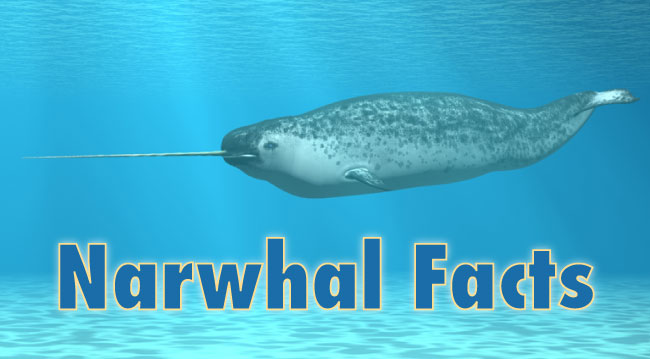This page contains narwhal facts, information, pictures and video. Read on to find out more about this mysterious Arctic whale ...
This article is part of our Arctic Animals series.
Narwhal Information
The Narwhal is known as the ‘unicorn of the ocean’ due to its distinctive horn, or tusk, and it is almost as mysterious as the mythical unicorn.
The Narwhal's scientific name is Monodon monoceros. It is a member of the Monodontidae family, which is itself part of a larger group of animals known as the 'toothed whales'.
The only other species in the Monodontidae family is the closely related Beluga Whale. You can find out more about Beluga Whales here: Beluga Whale Facts.
The Narwhal's Name (Warning: It's A Bit Gruesome!)
The name narwhal comes from the Norse word ‘nar’, which means ‘corpse’. It refers to the mottled skin of the narwhal, which was thought to resemble the bodies of drowned sailors.
The Narwhal's Tusk
The huge spiral tusk of the Narwhal is in fact an extended tooth which grows from a male narwhal’s upper jaw. The narwhal’s tusk can be as long as 10 feet (3 meters) long! Tusks can be used for fighting and also have a role in sensing the environment, as they containing 10 million nerve endings.
‘Tusking’ is when males rub their tusks together. It is thought that this is done either to establish dominance or for maintenance of the tusk.
Narwhal Facts & Figures: How Big is a Narwhal?
Even baby narwhals are a huge 5 feet (1.5 meters) long and can weigh as much as 220 pounds (100 kilograms). Adults can be as big as a whopping 20 feet (6 meters) long and can weigh 4,000 pounds (2,000 kilograms).
It is thought that Narwhals live to be around 50 years old, but they may live even longer.
You can learn more narwhal facts by watching this awesome video:
What Do Narwhals Eat?
A narwhal’s diet consists of squid, fish and shrimps. Narwhals can be found chowing down at the ice floe edge and in ice-free summer waters. Narwhals are hungrier in the winter and store up energy. Narwhals don’t have many teeth and feed by ‘hoovering up’ their prey with forceful suction.
Where do Narwhals Live?
Around 80,000 Narwhals live in the wild today and they can be found in the chilly waters of the Arctic near Canada, Greenland and Russia. In the warmer summer months, Narwhals can be found closer to shore, but they migrate out to sea and live under pack ice in the winter.
Narwhal Families
Narwhals tend to travel in groups called ‘pods’ which generally number around 10 to 20 individuals.
Female Narwhals can start to have babies when they are 5 to 8 years old, and give birth once every 3 years. It takes around 14 months for a Narwhal baby, a calf, to be born and only 1 calf tends to be born at a time. Mums will look after their calves for over a year until they can care for themselves.
Threats to Narwhals
The narwhal’s natural predators include Polar Bears and Orcas. Narwhals are also hunted (legally) by native Inuit people, who use all parts of the whale for food, tools and even for making art.
Climate change can affect Narwhals by reducing pack ice in the winter and affecting the numbers of arctic fish to feed on.
Awesome Narwhal Facts
- Narwhals belong to the toothed whale family, which also contains bottlenose dolphins, beluga whales and orcas
- Narwhals can ‘talk’ to each other with squeals, trills and clicks
- Narwhals have no dorsal fin which makes it easier for them to swim under ice
- Narwhal gatherings of up to several thousand individuals have been seen.
- Some males can have 2 tusks.
- Narwhals can dive over a mile deep and can spend up to 25 minutes underwater at a time.
- Narwhals change colour during their lives; babies are blue-grey, adults mottled grey and the ‘oldies’ are almost completely white.
- Narwhals can sometimes be suffocated when the sea ice freezes over.
- Fossil evidence shows that ancient white whales lived in tropical waters
- The scientific name for a narwhal is Monodon Monoceros, which in Greek means, ‘one-tooth, one-horn’.
Discover More with Active Wild
You can discover more amazing Arctic animals on this page: Artic Animals List with Pictures & Facts



